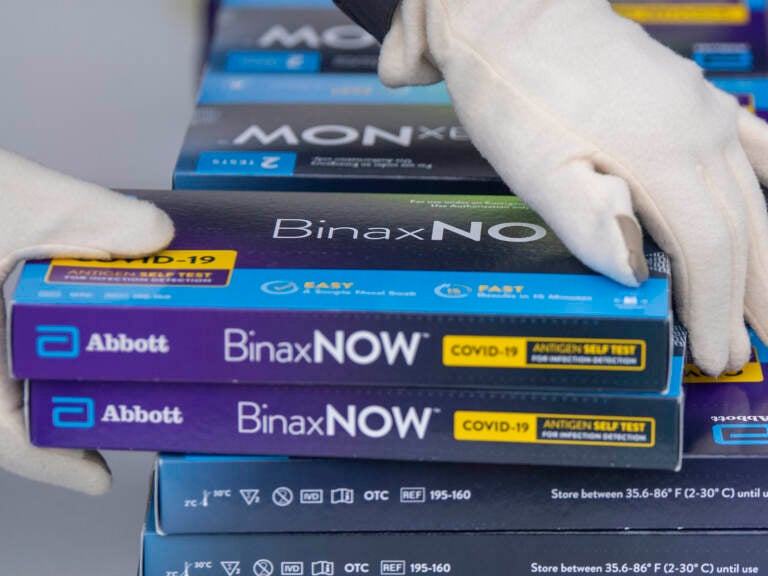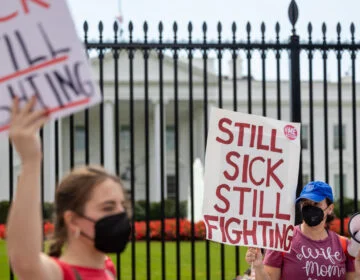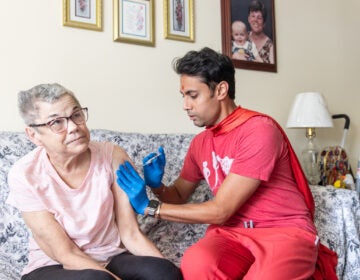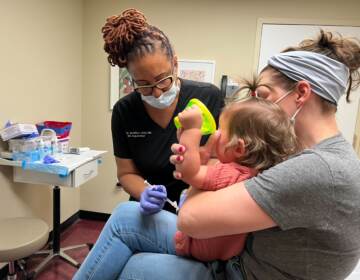How do free at-home COVID tests help if you’re blind and can’t see the results?
The Biden administration is providing free at-home swab tests for COVID-19. But they come with significant barriers for the blind community.
Listen 4:07
File photo: A health worker grabs at-home COVID-19 test kits to be handed out. (David Dermer/AP)
Ask us about COVID-19: What questions do you have about the coronavirus and vaccines?
This is one of a series of articles in which reporters from WHYY’s Health Desk Help Desk answer questions about vaccines and COVID-19 submitted by you, our audience.
The goal of the federal government’s website for ordering free COVID-19 rapid tests for home delivery is to alleviate a shortage. Health officials say that’s an important step in widely distributing critical tools to help curb the pandemic.
But at-home tests, whether bought from the website or at a local pharmacy, don’t mean access for everyone. The blind community is urging officials to remove barriers to being able to take the tests and read the results.
Most at-home COVID-19 tests involve using a nasal swab, then inserting the swab into a solution inside a test tube. Users then drop the solution onto something akin to a pregnancy test. The number of lines a user sees on the stick indicates if a person is positive or negative for the coronavirus.
Mark Riccobono, president of the National Federation of the Blind, wrote a letter to the White House in early January urging the Biden administration to address the needs of the blind community.
“We applaud you for acting swiftly and decisively during this health crisis, but we are still worried that inaccessibility will prevent millions of Americans from proactively protecting their health and preventing the spread of COVID-19,” the letter reads. “The blind have already faced many barriers during the pandemic, including inaccessible websites and drive-through-only testing sites, and these experiences reinforce the urgency of your administration addressing accessibility now.”
The letter urges the administration to ensure that its website is accessible to blind people, that blind people are able to access the community centers distributing the tests, and that they be able to take the tests in their homes independently. That would involve working with test manufacturers to create “innovative solutions” that will serve blind people and those with low vision, the letter reads.
Warren Knight of Philadelphia, who is blind, used to get tested once a week for his work, taking public transportation or a rideshare to his local CVS. He said being able to take the test at home would have been more convenient and more comfortable, and would have afforded him more privacy. It would also provide warmth on a particularly cold day, Knight said.
“When it’s cold outside, when it’s snowing outside, or if it’s raining outside, the Uber driver would take you back to where the booth is, and then some drivers would take you up to the ramp,” he said, “but just being out in the elements … if you have a service dog, now you’re out in the elements, where you don’t have to be out in the elements [with an at-home COVID-19 test].”
Knight lives alone, and the only way he could take an at-home COVID-19 test would be to ask a friend or family member to stop by his house and help him. But if he had symptoms, that wouldn’t be an option.
“Would you want to come into someone’s house that may have COVID?” Knight asked. “Or I might not have COVID, but you have it, and you just gave it to me.”
He said he feels as if health officials haven’t even acknowledged the barriers that people of different abilities face.
“No one has ever said, ‘Hey, we know some of our Americans or some of our citizens are unable to access the test that we have, but we’re working on it,’ even if they’re just blowing smoke up us, at least saying something,” Knight said.
“It’s just a little disturbing just not being included. Being blind a lot of times we are always excluded,” he said.
“It’s just kind of upsetting because we’re all in this together, because the virus does not discriminate. It doesn’t discriminate if you’re Black, white, if you can hear, if you can’t hear, if you can see, you can’t see. We’re all in this together. So if you put one group aside, they’re just going to be passed among each other or passed back to somebody else. So we all have to be included in this.”
Accessible Pharmacy Services for the Blind, a home-delivery pharmacy service in Fairless Hills, Bucks County, has taken its own steps to make at-home COVID-19 tests more accessible. People are able to use the Be My Eyes app to connect with pharmacy staff, who can walk them through the test and give them their results over video.
CEO Andy Burstein said the service aims to address several challenges that exist for blind and visually impaired people, such as the uncertainty that the people around them at testing sites are keeping 6 feet apart — making a retail environment stressful to begin with — as well as not being able to read instructions, administer the test, or read the results.
“To the extent that people can reduce the likelihood of having to travel, it’s also very difficult for someone who’s blind to potentially gain access to a pharmacy. For someone who lives in a rural community, gaining access to paratransit or having someone in their family take them adds another layer of complications,” Burstein said. “And there’s also some people that are showing symptoms and they’re reluctant to leave their home in general, and they’d like to be able to do this in the privacy and safety of their home for not only themselves, but for potentially other people who they may ultimately expose it to in the event that they’re positive.”
One of the challenges his company faces is gaining access to the supply of tests and the fluctuation of prices. In most cases, the test offered by Accessible Pharmacy is paid for by insurance, but there also is a $50 service fee.
States like New Jersey and Delaware offer free, home-delivered COVID-19 tests. One of the tests available, offered by Vault, is done over video conference.
A spokesperson for Vault said in an email that several blind people have successfully used its at-home COVID-19 tests. The most difficult part is reading the ID number off the test, she said, though test supervisors are able to guide the user to hold up the test to the camera so they can read the number.
But advocates such as the National Federation for the Blind are calling for at-home COVID-19 tests that blind people can use by themselves. Other medical devices, such as glucose monitors for instance, still aren’t as readily available or as affordable as they should be, they say. Yet some strides have been made — for example, there are available thermometers that speak to users. Advocates say that kind of technology should be available for COVID-19 tests.
“I know when we were raising our children, the only thing we found that was pretty helpful, we had one that spoke what the temperature was,” said Gary Pizzolo of Newark, Delaware. Both he and his wife are blind. “My wife has a blood pressure gauge that tells you the pressure and all that. So, it’s getting better. It’s just that there’s not a lot of availability, and if it’s out there, it’s very expensive.”
Pizzolo said he ordered the free at-home COVID-19 tests for his family in case they ever need to use one, but he’s unsure how he or his wife would do that. Their 16-year-old twins would likely have to help them, he said.
“I would tell the representatives that we need some type of system where it vibrates or beeps,” Pizzolo said.
Wayne Marsh of Newark, Delaware, is in a similar boat, but he lives alone.
“I’ve ordered them, but what am I going to do with them?” he asked.
“It shouldn’t be that big a deal. Same thing goes for appliances and exercise equipment. I can’t get a treadmill or a telephone because it’s not accessible to me, and that’s ridiculous. I had to buy a sensor for the wheel of my spin bike that was accessible with my iPhone. So I was able to hack my own system to be able to know what’s my heart rate or what’s my speed, and things like that. We should be included from the beginning,” Marsh said.
“Apple, for instance, builds everything with universal accessibility in mind. So, right out of the box, their products are accessible to as many people as they possibly can make it,” he said. “So if we built things from the ground up with that sort of mindset, it’s not that difficult. The difficulty is in trying to retrofit things.”

Get daily updates from WHYY News!
WHYY is your source for fact-based, in-depth journalism and information. As a nonprofit organization, we rely on financial support from readers like you. Please give today.





![CoronavirusPandemic_1024x512[1]](https://whyy.org/wp-content/uploads/2020/03/CoronavirusPandemic_1024x5121-300x150.jpg)


